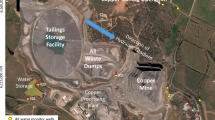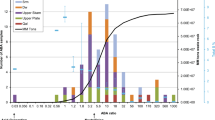Abstract
Managing the appropriate disposition of waste rock is a critical function of hard rock mining given the propensity of some materials to be acid-generating and the increasing environmental stewardship role of the mining industry. At most Newmont Mining Corporation mine sites, the net carbonate value (NCV) classification is used to partition mine waste according to acid generating potential; these are often further segregated into seven material types ranging from ‘highly acidic’ to ‘highly basic’. Although the NCV classification is generally a good predictor of acid-generating potential, humidity cell test (HCT) results for the NCV types ‘slightly basic’ and ‘inert/neutral’ were occasionally anomalous compared to the anticipated NCV-based acid-generating potential because acid generated by soluble aluminum and iron sulfates was not accounted for in the NCV test. This study was undertaken to develop an improved waste rock acid estimator using a battery of tests and to develop appropriate termination criteria for HCTs used to determine the potential for acid generation by waste rock. The HCTs were assessed for net alkalinity, pH, a molar ratio of (Ca + Mg/sulfate), and carbonate dissolution versus pyrite oxidation rates for HCTs over the 20 week period and/or the HCT forecast after 20 weeks. The results of HCTs compared with a combination of NCV, paste pH, and net acid generation (NAG) pH represents a simple tool to enhance screening run-of-mine waste for disposition to an appropriate storage location.






Similar content being viewed by others
References
Akabzaa TM, Armah TEK, Baneong-Yakubo BK (2007) Prediction of acid mine drainage generation potential in selected mines in the Ashanti metallogenic belt using static geochemical methods. Environ Geol 52:957–964
Allison JD, Brown DS, Novo-Gradac KH (1991) MINTEQA2—a geochemical assessment model for environmental systems. US Environmental Protection Agency Environmental Research Laboratory, Center for Exposure Assessment Modeling, EPA/6003-91/021, Athens, GA, 92 pp
American Society for Testing and Materials (1996) Standard test method for accelerated weathering of solid materials using a modified humidity cell. ASTM D 5744-96, West Conshohocken, PA, USA, 13 pp
American Society for Testing and Materials (2007a) Standard test method for accelerated weathering of solid materials using a modified humidity cell. ASTM D 5744-07, West Conshohocken, PA, USA, 19 pp
American Society for Testing and Materials (2007b) Standard test methods for analysis of metal bearing ores and related materials by combustion infrared-absorption spectrometry. ASTM E 1915-07, West Conshohocken, PA, USA, 14 pp
BLM (1996) Instruction memorandum 96–79. April 2. US Bureau of Land Management, Washington, DC, USA, 6 pp
Brodie MJ, Broughton LM, Robertson AM (1991) A conceptual rock classification system for waste management and a laboratory method for ARD prediction from rock piles. Proceedings of 2nd International Conference on the Abatement of Acidic Drainage, Montreal, Canada, Tome 3, pp 119–135
Day SJ (1989) Comments after presentation of “A practical approach to testing for acid mine drainage in the mine planning and approval process”. 13th Annual British Columbia Mine Reclamation Symp, Vernon, BC, Canada
Ferguson KD, Morin KA (1991) The prediction of acid rock drainage—lessons from the database. Proceedings of 2nd International Conference on the Abatement of Acidic Drainage, Montreal, Canada, Tome 3, p 83–106
Lengke MF, Tempel RN (2005) Geochemical modeling of arsenic sulfide oxidation kinetics in a mining environment. Geochim Cosmo Acta 69:341–356
Miller SD (1998) Predicting acid drainage. Australian minerals and energy environment foundation groundwork. 2:8–9
Morin KA, Hutt NM (1994) Observed preferential depletion of neutralization potential over sulfide minerals in kinetic tests—site specific criteria for safe NP/AP ratios. Proceedings of International Land Reclamation and Mine Drainage Conference on the Abatement of Acidic Drainage, US Bureau of Mines SP 06A-94, Pittsburgh, PA, USA, pp 148–156
NDEP (1990) Waste rock and overburden evaluation version 1.4.94 (Sept 14, 1990). Nevada Div of Environmental Protection, Bureau of Mining Regulation and Reclamation, Carson City, NV, USA, 2 pp
Nordstrom DK, Alpers CN (1999) Geochemistry of acid mine waters. In: Plumlee GS, Logsdon MJ (eds) The environmental geochemistry of mineral deposits, Part A: processes, techniques, and health issues, vol 6A. Rev Econ Geol, pp 133–160
Parkhurst DL, Appelo CAJ (1999) User’s guide to PHREEQC (version 2)—a computer program for speciation, batch-reaction, one-dimensional transport, and inverse geochemical modeling. US Geological Survey WRI Report 99-4259, Denver, CO, USA, 310 pp
Plumlee GS (1999) The environmental geology of mineral deposits. In: Plumlee GS, Logsdon MJ (eds) The environmental geochemistry of mineral deposits, Part A: processes, techniques, and health issues, vol 6A. Rev Econ Geol, pp 71–116
Sobek AA, Schuller WA, Freeman JR, Smith RM (1978) Field and laboratory methods applicable to overburden and minesoils. US Environmental Protection Agency Report EPA-600/2-78-054, 203 pp
US Environmental Protection Agency (1994) Acid mine drainage prediction. EPA-530-R-94-036, Washington, DC, USA, 48 pp
US Environmental Protection Agency (2009) Method 1627: kinetic test method for the prediction of mine drainage quality. EPA-530-R-94-056, Washington, DC, USA, 40 pp
White WW III, Lapakko KA, Cox RL (1999) Static-test methods most commonly used to predict acid-mine drainage. In: Plumlee GS, Logsdon MJ (eds) The environmental geochemistry of mineral deposits, Part A: processes, techniques, and health issues, vol 6A. Rev Econ Geol, pp 325–338
Acknowledgments
We are grateful to Paul Pettit, Ronald Clarke, Steve Grusing, and Nathan Bennett from Newmont Mining Corporation for providing us with data, insight, information, and advice. We thank Dr. Ted Eary for handling the manuscript, and W.W. White III and an anonymous reviewer for their constructive comments, which greatly improved the manuscript.
Author information
Authors and Affiliations
Corresponding author
Rights and permissions
About this article
Cite this article
Lengke, M.F., Davis, A. & Bucknam, C. Improving Management of Potentially Acid Generating Waste Rock. Mine Water Environ 29, 29–44 (2010). https://doi.org/10.1007/s10230-009-0097-1
Received:
Accepted:
Published:
Issue Date:
DOI: https://doi.org/10.1007/s10230-009-0097-1




